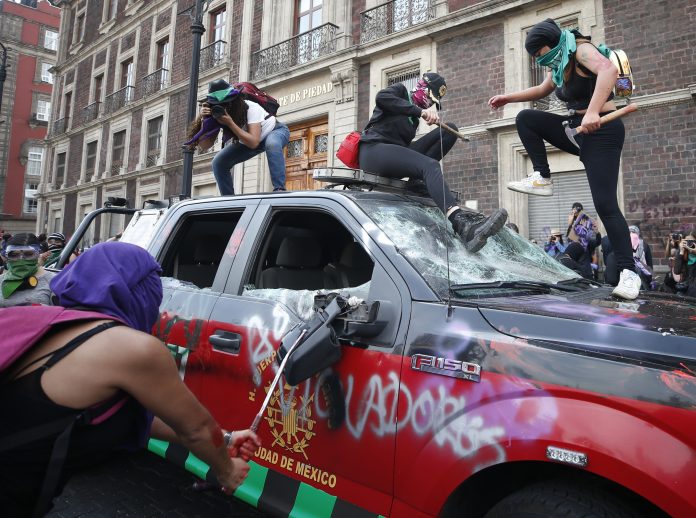
Untold thousands of women across Mexico stayed home from work and school Monday as part of a strike billed as “A Day Without Women,” hours after an unprecedented number of them filled the streets to protest rampant and rising gender violence on International Women’s Day.
Central streets in the capital were eerily empty of women and girls in the morning, as mostly men could be seen walking to offices, getting off buses or lining up to buy coffee. At least some metro ticket stations were closed, and President Andrés Manuel López Obrador’s morning press conference was dotted with empty seats as female journalists joined the strike as well.
López Obrador said his government was functioning during the strike and that it wasn’t yet clear how many federal employees were observing it. The president said it was up to each worker to decide what to do, in accordance with their personal beliefs and levels of responsibility.
The back-to-back protests mark an intensification of the struggle by Mexican women against violence and impunity in one of the most dangerous countries in the world for females. Women in Argentina and Chile have staged strikes in previous years and were also to do so again Monday.
“What we want to provoke is that they see that if we’re not there, the city won’t circulate. That there are many of us. What are they going to do without us if they are killing us?” said Viviana Mendez, a lawyer and mother supporting the strike.
The idea was to become invisible for a day so that coworkers, bosses, boyfriends, husbands and in some cases children reflect on the absence of each participating woman. Some also swore off social media until Tuesday.
Some women could be seen Monday jogging or working at taco stands, coffee shops or other jobs. At a central intersection, a female transit officer waved cars through. But overall, the relative absence of women in public spaces was striking.
Government data say 3,825 women met violent deaths last year, 7% more than in 2018. That works out to about 10 women slain each day in Mexico. Thousands more have gone missing without a trace in recent years. Authorities seem incapable of preventing or properly investigating the crimes, very few of which result in convictions.
“In Mexico it’s like we’re in a state of war; we’re in a humanitarian crisis because of the quantity of women that have disappeared or been killed,” said María de la Luz Estrada, coordinator of the National Citizen’s Observatory of Femicide.
Asked about his government’s strategy for combatting violence against women and impunity for such crimes, López Obrador said Monday that his administration is working on the issue every day. Echoing his policy for addressing broader violence, the president stressed the importance of tackling social ills such as poverty and inequality.
“I maintain that the main thing is to guarantee the well-being of the people,” López Obrador said.
Tougher criminal penalties and more aggressive prosecutions can help, he added, but “the main thing is that we live in a better society in all senses.”
He also repeated previous assertions that some of the anger directed at his administration over the violence against women “is conservatism disguised as feminism.”
A Facebook group called “A Day Without Women” has more than 320,000 Mexican members who have been debating and informing each other about the possible consequences of not going to the office, hospital or school for one day.
Officials estimated that 80,000 women marched Sunday in Mexico City, many wearing lavender. Some remarked that it seemed symbolically meaningful that the color matched the jacarandas blooming overhead for springtime. Some protesters spray painted messages like “Mexico kills women” onto monuments, smashed windows and set fires. The great majority marched peacefully. There were smaller demonstrations elsewhere in the country
Protesters tinted red the water of the fountain to the Roman goddess Diana in Mexico City to symbolize the blood of victims and also the water of a fountain to the Roman goddess of wisdom, Minerva, in Guadalajara.
Activists then stenciled the names of victims on Mexico City’s central Zocalo square. The names came from public records of deaths that appear to fall into the category of femicide, meaning those women’s killings showed marks of hatred for the female gender.
The call to protest grew in February after two murders rocked Mexico City: that of a young woman horribly disfigured, apparently by a boyfriend, and that of a 7-year-old girl abducted from her school. Murders of women in Mexico are often accompanied by sexual violence and stunning brutality.
Many businesses, from banks and media companies to law firms, supported the strike. The business confederation Coparmex encouraged its more than 36,000 member companies across the country to take part, despite calculating losses in the hundreds of thousands of dollars.
Some private schools canceled bus services that depend on female nannies to walk children to their front doors, or some enlisted fathers of schoolchildren to give classes in the absence of female teachers.
“No going out,” said Natalia Olalde, an 18-year-old university student, “not even for a coffee.”



















